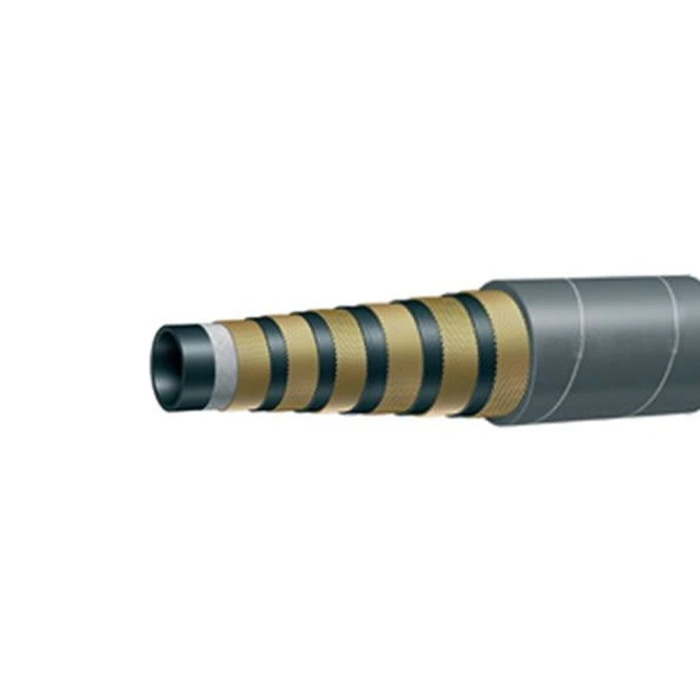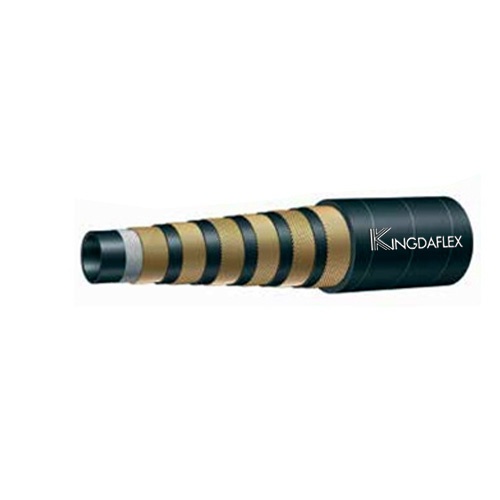We offer robust 6-wire hydraulic hoses, engineered for the most demanding high-pressure applications. These hoses feature six layers of high-tensile steel wire reinforcement, providing exceptional strength and durability. Designed to withstand extreme pressures and harsh environments, our 6-wire hoses ensure reliable performance and safety in heavy-duty hydraulic systems.
The six-wire reinforcement provides exceptional resistance to abrasion, cuts, and punctures, ensuring a longer lifespan compared to hoses with fewer wires.
Despite their strength, 6-wire hoses offer a good degree of flexibility, making them easier to install and maneuver in various environments.
Designed to handle high-pressure hydraulic fluids, 6-wire hoses are ideal for demanding applications where pressure is a critical factor.
These 6-wire spiral hydraulic hoses are typically designed to withstand a wide range of temperatures, ensuring reliable performance in both hot and cold conditions.

SAE 100R13 is a specific standard for hydraulic hoses, and 6-wire refers to the number of steel wire reinforcements within the hose. This combination indicates a hose that is well-suited for a wide range of industrial applications, particularly those involving high pressures and demanding environments.

SAE 100R15 is a specific designation for a type of 6-wire hydraulic hose, indicating its compliance with the Society of Automotive Engineers (SAE) standard for hydraulic hoses. This designation signifies a high-performance hose designed to withstand demanding applications.
A 6-wire hydraulic hose is a type of high-pressure hose designed for extremely demanding hydraulic applications. Its defining characteristic is the six layers of high-tensile steel wire reinforcement woven around the inner tube. This multi-layered wire braiding provides exceptional strength and pressure-bearing capacity, allowing the hose to handle very high operating pressures without bursting or expanding excessively. These hoses are engineered for situations where standard 2-wire or 4-wire hydraulic hoses would not suffice.
The construction of a 6-wire hydraulic hose typically involves a synthetic rubber inner tube, multiple layers of wire braiding, and a durable outer cover. The inner tube is chosen for its compatibility with the hydraulic fluid and its ability to withstand the fluid’s temperature and chemical properties. The wire braiding provides the structural integrity, while the outer cover protects the reinforcement layers from abrasion, weathering, and other environmental factors. This robust construction makes 6-wire hoses essential in heavy-duty industrial applications where reliability and safety are paramount.
A 6-wire hydraulic hose is constructed to handle extreme high-pressure hydraulic applications. Its structure is composed of several key layers:
Inner Tube (Core):
A synthetic rubber layer that conveys the hydraulic fluid.
Six Layers of High-Tensile Steel Wire Reinforcement:
Braided layers that provide exceptional strength and pressure resistance.
Outer Cover (Jacket):
A durable synthetic rubber layer that protects the reinforcement from abrasion, weathering, and environmental damage.
6-wire hydraulic hoses are designed for the most demanding high-pressure hydraulic applications. Their robust construction, featuring six layers of high-tensile steel wire reinforcement, enables them to handle extreme pressures and harsh environments. These hoses are essential in industries where reliability and safety are paramount, ensuring smooth and efficient operation of heavy machinery.
Heavy Construction Equipment
In heavy construction equipment such as large excavators, bulldozers, and cranes, 6-wire hydraulic hoses are indispensable. These machines operate under immense pressure to lift, move, and manipulate heavy loads. The hoses power critical functions like hydraulic cylinders, booms, and attachments, ensuring precise control and reliable performance. Their ability to withstand extreme pressures and resist abrasion makes them ideal for the rugged conditions of construction sites, minimizing downtime and maximizing productivity.
Mining Operations
Mining operations subject hydraulic systems to extreme stress, requiring hoses that can endure high pressures and abrasive environments. 6-wire hydraulic hoses are crucial for powering mining equipment like drills, loaders, and haul trucks. These hoses enable the efficient extraction and transportation of minerals, ensuring continuous operation and safety. Their durability and resistance to wear and tear are essential for the demanding conditions of mining sites, preventing costly failures and maintaining operational efficiency.
Oil and Gas Industry
The oil and gas industry demands hydraulic systems capable of handling extreme pressures and corrosive fluids. 6-wire hydraulic hoses are vital for powering offshore drilling platforms, well servicing equipment, and pipeline maintenance tools. These hoses ensure safe and reliable operation in harsh marine and land-based environments. Their ability to withstand high pressures and resist chemical degradation is crucial for the demanding applications in the oil and gas sector, ensuring safety and efficiency.
Heavy Industrial Machinery
In heavy industrial settings like steel mills, foundries, and large manufacturing plants, hydraulic systems power essential machinery such as presses, forging equipment, and large material handling systems. 6-wire hydraulic hoses ensure the reliable transfer of hydraulic fluid under extreme pressures, enabling precise control and efficient operation. Their robust construction and high-pressure ratings make them ideal for these demanding applications, ensuring continuous productivity and minimizing downtime.
6-wire hydraulic hoses are often constructed with a spiral wire reinforcement pattern to enhance their performance in extremely high-pressure applications. This spiral design provides superior structural integrity and flexibility compared to traditional braided reinforcement.
Understanding the benefits of this spiral construction helps explain why it’s preferred for demanding hydraulic systems.
Enhanced Pressure Resistance
The spiral wire reinforcement in 6-wire hydraulic hoses provides exceptional resistance to high pressures. The spiral pattern distributes pressure more evenly across the hose’s layers, minimizing the risk of bursting or expanding under extreme loads. This design allows the hose to maintain its dimensional stability and structural integrity, ensuring reliable performance in demanding hydraulic applications.
Improved Flexibility and Bend Radius
Despite their robust construction, 6-wire hydraulic hoses with spiral reinforcement offer improved flexibility and a tighter bend radius. The spiral pattern allows the hose to flex and bend more easily without kinking or collapsing, which is crucial in applications with complex routing or limited space. This flexibility enhances the hose’s usability and extends its lifespan by reducing stress on the hose and fittings.
Increased Durability and Longevity
The spiral wire reinforcement contributes to the overall durability and longevity of 6-wire hydraulic hoses. The tightly wound spiral layers provide excellent resistance to external abrasion, impact, and fatigue. This robust construction ensures that the hose can withstand the harsh conditions of heavy-duty industrial applications, minimizing downtime and maintenance costs.
Reduced Hose Expansion and Contraction
The spiral wire pattern also minimizes hose expansion and contraction under high-pressure cycles. This dimensional stability is essential for maintaining consistent hydraulic system performance and preventing leaks. By reducing hose movement, the spiral reinforcement helps ensure a secure and reliable connection between the hose and fittings, enhancing overall system safety and efficiency.
6-wire hydraulic hoses are designed for the most extreme high-pressure hydraulic applications, making them essential in industries where robust and reliable fluid transfer is critical. Their exceptional strength and durability ensure they can handle demanding conditions, contributing to the efficient operation of heavy machinery and industrial systems.
Heavy-Duty Construction and Mining:
6-wire hydraulic hoses are indispensable in heavy-duty construction and mining equipment such as large excavators, bulldozers, and mining drills. These applications require hoses capable of withstanding immense pressures and abrasive environments. They power critical functions like hydraulic cylinders, booms, and heavy lifting mechanisms, ensuring reliable performance and minimizing downtime in rugged terrain.
Offshore Oil and Gas Operations:
In the offshore oil and gas industry, 6-wire hydraulic hoses are vital for powering drilling platforms, subsea equipment, and well servicing tools. These applications demand hoses that can handle extremely high pressures and corrosive fluids in harsh marine environments. They ensure safe and efficient operation of critical equipment, contributing to the extraction and processing of oil and gas resources.
Heavy Industrial Machinery:
6-wire hydraulic hoses are crucial in heavy industrial machinery such as large hydraulic presses, forging equipment, and steel mill machinery. These applications require hoses capable of withstanding extreme pressures and high temperatures. They facilitate precise control and efficient operation of heavy machinery, ensuring consistent production and minimizing downtime in demanding industrial settings.
Aerospace and Defense:
In the aerospace and defense sectors, 6-wire hydraulic hoses are used in applications requiring high-pressure fluid transfer, such as aircraft landing gear systems, missile systems, and heavy-duty military equipment. These hoses ensure reliable performance under extreme conditions, contributing to the safety and effectiveness of critical aerospace and defense operations.
We are leading hydraulic hose manufacturer from China, and please feel free to contact us at any time if you are looking for hydraulic hoses, hydraulic hose fittings, industrial hoses, and other hose related products. Welcome to get in touch with us any time to get more hose solutions for your projects.
If you are looking for a professional hydraulic hose & industrial hose manufacturer, Kingdaflex will be your best choice. We provide better hydraulic hose wholesale and the best solution to help your hydraulic projects. Welcome to contact us at any time.